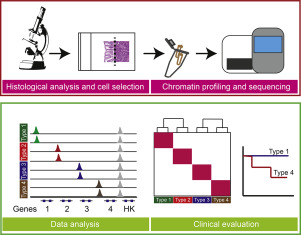当前位置:
X-MOL 学术
›
Biochim Biophys Acta Rev Cancer
›
论文详情
Our official English website, www.x-mol.net, welcomes your feedback! (Note: you will need to create a separate account there.)
Principles and methods of integrative chromatin analysis in primary tissues and tumors.
Biochimica et Biophysica Acta (BBA) - Reviews on Cancer ( IF 11.2 ) Pub Date : 2019-11-22 , DOI: 10.1016/j.bbcan.2019.188333 Paloma Cejas 1 , Henry W Long 2
Biochimica et Biophysica Acta (BBA) - Reviews on Cancer ( IF 11.2 ) Pub Date : 2019-11-22 , DOI: 10.1016/j.bbcan.2019.188333 Paloma Cejas 1 , Henry W Long 2
Affiliation

|
Recent methodological advances have enabled the genome-wide interrogation of chromatin from primary tumor tissues. Integrative analysis of histone post-translational modifications, transcription factor (TF) binding and open chromatin sites in tumors across cancer stages can elucidate the aberrant epigenetic states accompanying tumor progression. Cancer-associated chromatin alterations can activate or inactivate enhancers at genes involved in cancer while still respecting cell-of-origin constrictions. Accordingly, enhancer analysis in cancer could have uses for biomarker discovery to further refine patient diagnosis and potentially sub-classify patients for tailored therapy. Methodologies used for chromatin analyses of primary tissues need to address issues distinct from cell line studies including the specific sources of variability coming from the heterogeneous cellular composition of tissues and from inter-individual (epi)genetic differences. This leads to requirements for careful histological analysis to select the specific samples and cells of interest. In analyzing tumors somatic changes should be taken into account to distinguish the genuine epigenetic changes across tumor specimens from any genetic alterations such as copy number variations (CNV). In this contribution we review a selection of current results from chromatin profiling, examine experimental methodologies and discuss specific analysis approaches. We also review specific considerations regarding tissue preparation for epigenetic analysis and conclude with our perspectives on emerging approaches that will impact studies of chromatin landscapes of clinical samples in the future.
中文翻译:

原发性组织和肿瘤中整合染色质分析的原理和方法。
最近的方法学进展使得从原发性肿瘤组织对染色质的全基因组研究成为可能。跨癌症阶段的肿瘤中组蛋白翻译后修饰,转录因子(TF)结合和开放的染色质位点的综合分析可以阐明伴随肿瘤进展的异常表观遗传状态。与癌症相关的染色质改变可以激活或灭活与癌症有关的基因上的增强子,同时仍然尊重起源细胞的收缩。因此,癌症中的增强子分析可用于生物标记物发现,以进一步完善患者诊断并可能对患者进行亚分类以进行量身定制的治疗。用于主要组织染色质分析的方法需要解决与细胞系研究不同的问题,包括组织异质性细胞组成和个体间(epi)遗传差异所致的特定变异性来源。这导致需要仔细的组织学分析以选择感兴趣的特定样品和细胞。在分析肿瘤时,应考虑体细胞变化,以区分肿瘤标本中真正的表观遗传学变化与任何遗传变化,例如拷贝数变异(CNV)。在这项贡献中,我们回顾了从染色质谱分析中选择的当前结果,研究了实验方法并讨论了特定的分析方法。
更新日期:2019-11-22
中文翻译:

原发性组织和肿瘤中整合染色质分析的原理和方法。
最近的方法学进展使得从原发性肿瘤组织对染色质的全基因组研究成为可能。跨癌症阶段的肿瘤中组蛋白翻译后修饰,转录因子(TF)结合和开放的染色质位点的综合分析可以阐明伴随肿瘤进展的异常表观遗传状态。与癌症相关的染色质改变可以激活或灭活与癌症有关的基因上的增强子,同时仍然尊重起源细胞的收缩。因此,癌症中的增强子分析可用于生物标记物发现,以进一步完善患者诊断并可能对患者进行亚分类以进行量身定制的治疗。用于主要组织染色质分析的方法需要解决与细胞系研究不同的问题,包括组织异质性细胞组成和个体间(epi)遗传差异所致的特定变异性来源。这导致需要仔细的组织学分析以选择感兴趣的特定样品和细胞。在分析肿瘤时,应考虑体细胞变化,以区分肿瘤标本中真正的表观遗传学变化与任何遗传变化,例如拷贝数变异(CNV)。在这项贡献中,我们回顾了从染色质谱分析中选择的当前结果,研究了实验方法并讨论了特定的分析方法。



























 京公网安备 11010802027423号
京公网安备 11010802027423号